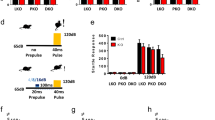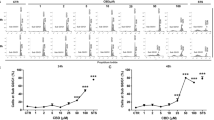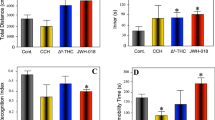Abstract
Cognitive impairment is one of the most important negative consequences associated with cannabis consumption. We found that CB1 cannabinoid receptor (CB1R) activation transiently modulated the mammalian target of rapamycin (mTOR)/p70S6K pathway and the protein synthesis machinery in the mouse hippocampus, which correlated with the amnesic properties of delta9-tetrahydrocannabinol (THC). In addition, non-amnesic doses of either the mTOR blocker rapamycin or the protein synthesis inhibitor anisomycin abrogated the amnesic-like effects of THC, pointing to a mechanism involving new protein synthesis. Moreover, using pharmacological and genetic tools, we found that THC long-term memory deficits were mediated by CB1Rs expressed on GABAergic interneurons through a glutamatergic mechanism, as both the amnesic-like effects and p70S6K phosphorylation were reduced in GABA-CB1R knockout mice and by NMDA blockade.
This is a preview of subscription content, access via your institution
Access options
Subscribe to this journal
Receive 12 print issues and online access
$209.00 per year
only $17.42 per issue
Buy this article
- Purchase on Springer Link
- Instant access to full article PDF
Prices may be subject to local taxes which are calculated during checkout






Similar content being viewed by others
References
Kano, M., Ohno-Shosaku, T., Hashimotodani, Y., Uchigashima, M. & Watanabe, M. Endocannabinoid-mediated control of synaptic transmission. Physiol. Rev. 89, 309–380 (2009).
Wise, L.E., Thorpe, A.J. & Lichtman, A.H. Hippocampal CB(1) receptors mediate the memory impairing effects of delta(9)-tetrahydrocannabinol. Neuropsychopharmacology published online, doi:10.1038/npp.2009.31 (25 March 2009).
Clarke, J.R. et al. Posttraining activation of CB1 cannabinoid receptors in the CA1 region of the dorsal hippocampus impairs object recognition long-term memory. Neurobiol. Learn. Mem. 90, 374–381 (2008).
Katona, I. et al. Presynaptically located CB1 cannabinoid receptors regulate GABA release from axon terminals of specific hippocampal interneurons. J. Neurosci. 19, 4544–4558 (1999).
Katona, I. et al. Distribution of CB1 cannabinoid receptors in the amygdala and their role in the control of GABAergic transmission. J. Neurosci. 21, 9506–9518 (2001).
Katona, I. et al. Molecular composition of the endocannabinoid system at glutamatergic synapses. J. Neurosci. 26, 5628–5637 (2006).
Kawamura, Y. et al. The CB1 cannabinoid receptor is the major cannabinoid receptor at excitatory presynaptic sites in the hippocampus and cerebellum. Neuroscience 26, 2991–3001 (2006).
Monory, K. et al. The endocannabinoid system controls key epileptogenic circuits in the hippocampus. Neuron 51, 455–466 (2006).
Takahashi, K.A. & Castillo, P.E. The CB1 cannabinoid receptor mediates glutamatergic synaptic suppression in the hippocampus. Neuroscience 139, 795–802 (2006).
Derkinderen, P. et al. Regulation of extracellular signal-regulated kinase by cannabinoids in hippocampus. J. Neurosci. 23, 2371–2382 (2003).
Rubino, T., Forlani, G., Viganò, D., Zippel, R. & Parolaro, D. Modulation of extracellular signal-regulated kinases cascade by chronic delta 9-tetrahydrocannabinol treatment. Mol. Cell. Neurosci. 25, 355–362 (2004).
Ozaita, A., Puighermanal, E. & Maldonado, R. Regulation of PI3K/Akt/GSK-3 pathway by cannabinoids in the brain. J. Neurochem. 102, 1105–1114 (2007).
Manning, B.D. & Cantley, L.C. AKT/PKB signaling: navigating downstream. Cell 129, 1261–1274 (2007).
Sekulić, A. et al. A direct linkage between the phosphoinositide 3 kinase–AKT signaling pathway and the mammalian target of rapamycin in mitogen-stimulated and transformed cells. Cancer Res. 60, 3504–3513 (2000).
Swiech, L., Perycz, M., Malik, A. & Jaworski, J. Role of mTOR in physiology and pathology of the nervous system. Biochim. Biophys. Acta 1784, 116–132 (2008).
Jaworski, J. & Sheng, M. The growing role of mTOR in neuronal development and plasticity. Mol. Neurobiol. 34, 205–219 (2006).
Costa-Mattioli, M., Sossin, W.S., Klann, E. & Sonenberg, N. Translational control of long-lasting synaptic plasticity and memory. Neuron 61, 10–26 (2009).
Richter, J.D. & Klann, E. Making synaptic plasticity and memory last: mechanisms of translational regulation. Genes Dev. 23, 1–11 (2009).
Jefferies, H.B. et al. Rapamycin suppresses 5′TOP mRNA translation through inhibition of p70s6k. EMBO J. 16, 3693–3704 (1997).
Lehman, J.A., Calvo, V. & Gomez-Cambronero, J. Mechanism of ribosomal p70S6 kinase activation by granulocyte macrophage colony-stimulating factor in neutrophils: cooperation of a MEK-related, THR421/SER424 kinase and a rapamycin-sensitive, m-TOR–related THR389 kinase. J. Biol. Chem. 278, 28130–28138 (2003).
Meyuhas, O. Physiological roles of ribosomal protein S6: one of its kind. Int. Rev. Cell Mol. Biol. 268, 1–37 (2008).
Ferrari, S. & Thomas, G. S6 phosphorylation and the p70s6k/p85s6k. Crit. Rev. Biochem. Mol. Biol. 29, 385–413 (1994).
Banko, J.L. et al. The translation repressor 4E-BP2 is critical for eIF4F complex formation, synaptic plasticity, and memory in the hippocampus. J. Neurosci. 25, 9581–9590 (2005).
Duncan, R.F., Peterson, H., Hagedorn, C.H. & Sevanian, A. Oxidative stress increases eukaryotic initiation factor 4E phosphorylation in vascular cells. Biochem. J. 369, 213–225 (2003).
Ehninger, D. et al. Reversal of learning deficits in a Tsc2+/− mouse model of tuberous sclerosis. Nat. Med. 14, 843–848 (2008).
Broadbent, N.J., Squire, L.R. & Clark, R.E. Spatial memory, recognition memory and the hippocampus. Proc. Natl. Acad. Sci. USA 101, 14515–14520 (2004).
Piomelli, D. et al. Pharmacological profile of the selective FAAH inhibitor KDS-4103 (URB597). CNS Drug Rev. 12, 21–38 (2006).
Kelleher, R.J. III, Govindarajan, A. & Tonegawa, S. Translational regulatory mechanisms in persistent forms of synaptic plasticity. Neuron 44, 59–73 (2004).
Banko, J.L. & Klann, E. Cap-dependent translation initiation and memory. Prog. Brain Res. 169, 59–80 (2008).
Bolduc, F.V., Bell, K., Cox, H., Broadie, K.S. & Tully, T. Excess protein synthesis in Drosophila fragile X mutants impairs long-term memory. Nat. Neurosci. 11, 1143–1145 (2008).
Kandel, E.R. Rapid increase in clusters of presynaptic proteins at onset of long-lasting potentiation. Science 294, 1030–1038 (2001).
Straiker, A. & Mackie, K. Cannabinoids, electrophysiology and retrograde messengers: challenges for the next 5 years. AAPS J. 8, E272–E276 (2006).
Elroy-Stein, O. et al. in Translational Control in Biology and Medicine, Translation Initiation via Cellular Internal Ribosome Entry Sites (ed. Mathews, M.B.) (Cold Spring Harbor Laboratory Press, Cold Spring Harbor, New York, 2008).
Gingras, A.C., Raught, B. & Sonenberg, N. eIF4 initiation factors: effectors of mRNA recruitment to ribosomes and regulators of translation. Annu. Rev. Biochem. 68, 913–963 (1999).
Wang, X. et al. Inhibition of mammalian target of rapamycin induces phosphatidylinositol 3-kinase–dependent and Mnk-mediated eukaryotic translation initiation factor 4E phosphorylation. Mol. Cell. Biol. 27, 7405–7413 (2007).
Carracedo, A. et al. Inhibition of mTORC1 leads to MAPK pathway activation through a PI3K-dependent feedback loop in human cancer. J. Clin. Invest. 118, 3065–3074 (2008).
Blundell, J., Kouser, M. & Powell, C.M. Systemic inhibition of mammalian target of rapamycin inhibits fear memory reconsolidation. Neurobiol. Learn. Mem. 90, 28–35 (2008).
Page, G. et al. Group I metabotropic glutamate receptors activate the p70S6 kinase via both mammalian target of rapamycin (mTOR) and extracellular signal–regulated kinase (ERK 1/2) signaling pathways in rat striatal and hippocampal synaptoneurosomes. Neurochem. Int. 49, 413–421 (2006).
Tsokas, P., Ma, T., Iyengar, R., Landau, E.M. & Blitzer, R.D. Mitogen-activated protein kinase upregulates the dendritic translation machinery in long-term potentiation by controlling the mammalian target of rapamycin pathway. J. Neurosci. 27, 5885–5894 (2007).
Gelinas, J.N. et al. ERK and mTOR signaling couple beta-adrenergic receptors to translation initiation machinery to gate induction of protein synthesis–dependent long-term potentiation. J. Biol. Chem. 282, 27527–27535 (2007).
Pearson, R.B. & Thomas, G. Regulation of p70s6k/p85s6k and its role in the cell cycle. Prog. Cell Cycle Res. 1, 21–32 (1995).
Kelleher, R.J. III & Bear, M.F. The autistic neuron: troubled translation? Cell 135, 401–406 (2008).
Wilson, R.I. & Nicoll, R.A. Endogenous cannabinoids mediate retrograde signaling at hippocampal synapses. Nature 410, 588–592 (2001).
Kim, M.H. et al. Enhanced NMDA receptor-mediated synaptic transmission, enhanced long-term potentiation, and impaired learning and memory in mice lacking IRSp53. J. Neurosci. 29, 1586–1595 (2009).
Ohno-Shosaku, T. et al. Presynaptic cannabinoid sensitivity is a major determinant of depolarization-induced retrograde suppression at hippocampal synapses. J. Neurosci. 22, 3864–3872 (2002).
Marsicano, G. et al. The endogenous cannabinoid system controls extinction of aversive memories. Nature 418, 530–534 (2002).
Varvel, S.A., Anum, E.A. & Lichtman, A.H. Disruption of CB(1) receptor signaling impairs extinction of spatial memory in mice. Psychopharmacology (Berl.) 179, 863–872 (2005).
Zimmer, A., Zimmer, A.M., Hohmann, A.G., Herkenham, M. & Bonner, T.I. Increased mortality, hypoactivity and hypoalgesia in cannabinoid CB1 receptor knockout mice. Proc. Natl. Acad. Sci. USA 96, 5780–5785 (1999).
Valjent, E. et al. Involvement of the extracellular signal–regulated kinase cascade for cocaine-rewarding properties. J. Neurosci. 20, 8701–8709 (2000).
Phillips, R.G. & LeDoux, J.E. Differential contribution of amygdala and hippocampus to cued and contextual fear conditioning. Behav. Neurosci. 106, 274–285 (1992).
Acknowledgements
We thank C. Fernández-Avilés for expert technical assistance, J. Bertran-Gonzalez for advice in immunohistochemical techniques and the Laboratori de Neurofarmacologia for helpful discussion. This study was supported by grants from the European Commission (CANSIGWITH (MIRG-6-CT-2005-014856) to A.O. and NEWMOOD (LSHM-CT-2004-503474) and GENADDICT (LSHM-CT-2004-05166) to R.M.), the Spanish Ministry of Health (FIS PI041526) to A.O., the Spanish Ministry of Science and Innovation (Consolider-C #SAF2007-64062), Generalitat de Catalunya (2005SGR00131) and ICREA Academia to R.M. A.O. is a recipient of a Ramon y Cajal award from the Spanish Ministry of Education and Culture, E.P. is a recipient of a predoctoral fellowship from the Spanish Ministry of Education and Culture and A.B.-G. is a recipient of a fellowship from La Caixa.
Author information
Authors and Affiliations
Contributions
E.P. conducted the biochemical, immunohistochemical and behavioral experiments and wrote the manuscript. G.M. provided CB1 conditional knockout mice. A.B.-G. conducted behavioral experiments and wrote the manuscript. B.L. provided CB1 conditional knockout mice. R.M. funded the project, participated in experimental design and wrote the manuscript. A.O. conceptualized, supervised and funded the project, participated in experimental design, and wrote the manuscript.
Corresponding author
Supplementary information
Supplementary Text and Figures
Supplementary Figures 1–10 (PDF 1042 kb)
Rights and permissions
About this article
Cite this article
Puighermanal, E., Marsicano, G., Busquets-Garcia, A. et al. Cannabinoid modulation of hippocampal long-term memory is mediated by mTOR signaling. Nat Neurosci 12, 1152–1158 (2009). https://doi.org/10.1038/nn.2369
Received:
Accepted:
Published:
Issue Date:
DOI: https://doi.org/10.1038/nn.2369
This article is cited by
-
EF1α-associated protein complexes affect dendritic spine plasticity by regulating microglial phagocytosis in Fmr1 knock-out mice
Molecular Psychiatry (2024)
-
Mitochondria as central hubs in synaptic modulation
Cellular and Molecular Life Sciences (2023)
-
Peripheral CB1 receptor blockade acts as a memory enhancer through a noradrenergic mechanism
Neuropsychopharmacology (2023)
-
Cellular messenger molecules mediating addictive drug-induced cognitive impairment: cannabinoids, ketamine, methamphetamine, and cocaine
Future Journal of Pharmaceutical Sciences (2022)
-
Opposite physiological and pathological mTORC1-mediated roles of the CB1 receptor in regulating renal tubular function
Nature Communications (2022)



